Byzantine lessons. To the 560 anniversary of the fall of Constantinople. Part of 2
The Ottomans. The conquest of the capital of Byzantium dreamed in dreams of the leaders of the Muslim armies for many centuries. Sultan Mehmed II, like his immediate predecessors, took the title Sultan-i-Rum, that is, "the ruler of Rome." Thus, the Ottoman sultans claimed the heritage of Rome and Constantinople.
Mehmed II returned to the throne in 1451 from the very beginning set himself the task of capturing Constantinople. The conquest of the Byzantine capital was to strengthen the political position of the Sultan and once and for all solve the problem of the enemy bridgehead in the center of the Ottoman possessions. The passage of Constantinople under the rule of a strong and energetic Western European ruler could seriously complicate the position of the Ottoman Empire. The city could be used as a base for the crusader army, under the rule fleet Genoa and Venice at sea.
The Byzantine emperor and other neighboring rulers at first believed that Mehmed did not pose a great danger. Such an impression came from the first attempt of the government of Mehmed in 1444 — 1446, when, due to army protest, he handed over the reins of government to his father (Murad transferred the throne to his son Mehmed, having decided to move away from state affairs). However, he proved by his affairs the opposite. Mehmed nominated his proxies — Zaganosa Pasha and Shihab al-Din Pasha — for the posts of the second and third viziers. This weakened the position of the old great vizier, Chandarly Khalil, who was in favor of a more cautious policy towards Byzantium. He ordered to kill his younger brother, getting rid of the claimant to the throne (this was the Ottoman tradition). True, there is one more challenger - Prince Orhan, who was hiding in Constantinople. His Byzantine emperor Constantine XI tried to use in a political game, bargained for relief from the Sultan, threatening to release Orhan, which could lead to civil war. However, Mehmed was not scared. He pacified the princedom of the Karamaids, having married the daughter of Ibrahim Bey, the ruler of Karaman.
Already in winter 1451 — 1452. The Sultan ordered the construction of a fortress to begin at the narrowest point of the Bosphorus (here the width of the strait was about 90 m). Rumeli-Gisar - Rumelian fortress (or "Bogaz-Kesen", translated from Turkish - "cutting the strait, throat") cut Constantinople from the Black Sea, in fact it was the beginning of the siege of the city. The Greeks (they still called themselves Romans “romey”) were confused. Constantine sent an embassy, which reminded of the oath of the Sultan - to preserve the territorial integrity of Byzantium. Sultan replied that this land was still empty, and besides, he ordered that Constantin be conveyed that he had no possessions outside the walls of Constantinople. The Byzantine emperor sent a new embassy, asked not to touch the Greek settlements located on the Bosphorus. The Ottomans ignored this embassy. In June, a third embassy was sent to 1452 - this time the Greeks were arrested and then executed. In fact, it was a declaration of war.
By the end of August 1452, the Rumelian fortress was built. It housed a garrison of 400 warriors under the command of Firuz Bey and set up powerful cannons. The largest of them could shoot cores weighing 272 kg. The garrison was ordered to sink all the ships that will sail by and refuse to pass the inspection. Soon the Ottomans confirmed the seriousness of their words: in the fall, two Venetian ships sailing from the Black Sea were driven off, and the third was sunk. The crew was hanged, and the captain was impaled.
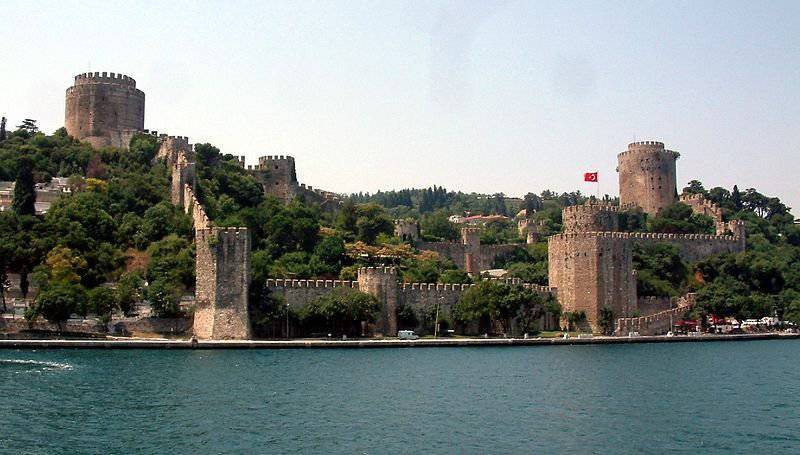
Rumelihisar, view from the Bosphorus.
At the same time, the Sultan was preparing the fleet and the army in Thrace. In the fall of 1452, troops were drawn to Edirne. Gunsmiths throughout the empire worked tirelessly. Engineers built battering and stone-throwing machines. Among the specialists of the gunsmiths at the court of the Sultan was the Hungarian master Urban, who left the service with the Byzantine emperor, since he could not pay the required amount and provide all the materials necessary for the production of tools of unprecedented power. When asked about the possibility of destroying the walls in Constantinople, Urban answered positively, although he admitted that he could not predict the range of fire. He cast several powerful tools. One of them had to transport 60 bulls, several hundred servants were assigned to him. The gun fired nuclei weighing approximately 450-500 kg. The firing range was more than one and a half kilometers.
Illegal shipments weapons, including guns, went to the Turks from Italy, including Ancon merchant associations. In addition, the Sultan had the means to invite the best casting masters and mechanics from abroad. Mehmed himself was a good specialist in this field, especially in ballistics. The artillery was reinforced by stone-throwing and wall-breaking machines.
Mehmed II assembled a powerful strike fist from about 80 of thousands of regular troops: cavalry, infantry and a corps of janissaries (about 12 thousand fighters). With irregular troops - militiamen, bashi-bazouks (from Turkic. “With a defective head”, “sick in the head”, recruited among the mountain tribes of Asia Minor, in Albania, they were extremely brutal), volunteers, the number of Ottoman army was over 100 thousand. In addition, the army was accompanied by a large number of "obiznik", merchants and merchants, and other "fellow travelers". In the fleet under the command of Balta oglu, Suleiman Bey (Suleiman Baltoglu) had 6 triplets, 10 birem, 15 galleys, near 75 fust (small high-speed vessels) and 20 heavy parandaria transports. Other sources report 350-400 ships of all types and sizes. The rowers and sailors in the Ottoman fleet were prisoners, criminals, slaves and part of the volunteers. In late March, the Turkish fleet passed through the Dardanelles to the Sea of Marmara, causing surprise and horror among the Byzantines and Italians. This was another miscalculation of the Byzantine elite, in Constantinople they did not expect the Turks to prepare such a significant naval forces and be able to block the city from the sea. The Turkish fleet was inferior to the Christian naval forces as a crew training, the ships were worse in seafaring, fighting qualities, but it had enough forces to blockade the city and to land the assault forces. And to lift the blockade, considerable naval forces were needed.
At the end of January 1453, the issue of the beginning of the war was finally resolved. Sultan ordered the troops to occupy the remaining Byzantine settlements in Thrace. Cities on the Black Sea capitulated without a fight and avoided defeat. Some settlements on the run of the Sea of Marmara tried to resist and were subject to pogrom. Part of the troops invaded the Peloponnese to divert the emperor's brothers, the rulers of the Morey despotism, from the main theater of operations. The ruler of Rumelia, Karadzha Pasha, put in order work from Edirne to Constantinople.
The Greeks
Konstantin XI Palaeologus was a good manager and a skilled warrior, he had a sound mind. Respected by his subjects. All the short years of his reign - 1449 — 1453, he tried to improve the defenses of Constantinople, looking for allies. His closest aide was the commander in chief of the fleet, Luca Notaras. In the face of an inevitable attack, the emperor was engaged in bringing food, wine, and agricultural tools to the city. People from the nearest villages moved to Constantinople. Throughout 1452-1453. Constantine sent ships to the Aegean Sea for the purchase of supplies and military equipment. Silver was taken out of churches and monasteries, jewels for paying salaries to troops.
Monument to Constantine Palaeologu opposite the cathedral in Athens.
In general, the city was mobilized. All reserves were sought to improve their defenses. Throughout the winter, the townspeople, men and women, worked, cleared ditches, strengthened the walls. A contingency fund has been established. The emperor, churches, monasteries, and individuals made contributions to it. It must be said that the problem was not even the availability of money, but the lack of the necessary number of soldiers, weapons (special firearms), the issue of supplying the city with food during the siege. All the weapons were decided to be assembled in one arsenal, in order to allocate, if necessary, to the most threatened areas.
The walls and towers, although they were old, represented a formidable force, with an appropriate number of soldiers, Constantinople was impregnable. However, the population decline made itself felt - Konstantin was able to collect only about 7 thousand soldiers, including a certain number of mercenaries and allied volunteers. There were few guns, and besides, the towers and walls did not have artillery sites, and when the gun was recovered, they destroyed their own fortifications. From the sea, the city defended a fleet of 26 ships: 10 Greek, 5 - Venetian, 5 - Genoese, 3 - from Crete, and one each from the city of Ancona, Catalonia and Provence.
The huge Turkish fleet in the Sea of Marmara, the enemy fortress, which cut off the city from the Black Sea, rumors of powerful Turkish artillery led to a decline in the spirit of the townspeople. Many believed that only God and the Virgin Mary could save the city.
Possible allies
Constantine XI Palaeologus repeatedly asked the Christian rulers for help with insistent requests. In February 1552, the Venetian Senate promised to help with military ammunition, otherwise limited to vague promises. Many Venetian senators believed Byzantium was already virtually lost, they wrote it off. There were proposals to improve relations with the Ottomans.
The Christian powers “helped” more by word than by deed. Shard of the former Byzantine Empire - Trapezund "empire" dealt with its problems. In the 15th century, the Comnenian dynasty, which ruled Trebizond, completely degenerated. The “Empire” paid tribute to the Ottomans and a few years after the fall of Constantinople, they were liquidated. Practically the last province of the Byzantine Empire, the Morea Despotati, with its capital in the city of Mystra, was attacked by the Ottomans in the autumn of 1552. Morea withstood the blow, but she did not have to wait for help from her. Small Latin enclaves in Greece also had no opportunity to help Constantinople because of its weakness. Serbia was a vassal of the Ottoman Empire and its military contingent participated in the siege of Constantinople. Hungary recently suffered a serious defeat from the Ottomans and did not want to start a new campaign.
The Venetians, after the death of their ship in the strait, thought about how to protect the caravans coming from the Black Sea. In addition, in the Byzantine capital they owned a whole block, the Venetians had significant privileges and benefits from trade in Byzantium. Venetian possessions in Greece and the Aegean Sea were also under threat. On the other hand, Venice was stuck in an expensive war in Lombardy. Genoa was an old rival enemy, relations with Rome were strained. Alone did not want to fight with the Ottomans. Moreover, I didn’t want to seriously spoil relations with the Turks - Venetian merchants conducted profitable trade in Turkish ports. As a result, Venice only allowed the Byzantine emperor to recruit soldiers and sailors in Crete, and generally remained neutral during this war. In April, the 1453 of the year, Venice decided to defend Constantinople. But the ships were collected so slowly and with such delays that when the Venetian fleet gathered in the Aegean Sea, he was already just late for help. In Constantinople itself, the Venetian community, including visiting merchants, captains and crews of ships, decided to protect the city. Not a single ship was supposed to leave the harbor. But at the end of February 1453, six captains ignored the instructions of the leader Girolamo Minotta and left, taking the 700 man away.
The Genoese were in about the same situation. Their concern was caused by the fate of Pera (Galati), which belonged to the Genoa quarter on the other side of the Golden Horn and the Black Sea colonies. Genoa showed the same cunning, as Venice. They pretended to want to help - the government appealed to the Christian world to send aid to Byzantium, but itself remained neutral. Private citizens have the right to freedom of choice. The authorities of Pera and the islands of Chios were instructed to adhere to the Ottomans such a policy, which they consider the most convenient in the current situation. Pera has maintained neutrality. Assistance to Constantinople was provided only by Genoese condottier Giovanni Giustiniani Longo. He brought two ships from 700 to well-armed soldiers, 400 of whom were recruited in Genoa, and 300 on the islands of Chios and Rhodes. It was the most numerous detachment that came to the aid of Constantinople. Later Giustiniani Longo will prove himself as the most active defender of the city, leading the land forces.
In Rome, they looked at the critical situation of Constantinople as an excellent opportunity to incline the Orthodox Church to a union. Pope Nicholas V, having received a letter from the Byzantine ruler with the consent to accept the union, sent messages of help to various sovereigns, but did not achieve a positive response. In the autumn of 1452, the Roman legate, Cardinal Isidore, arrived in the Byzantine capital. He arrived at the Venetian gallery and brought with him 200 archers and soldiers with firearms hired in Naples and Chios. In Constantinople, it was considered that this was the vanguard of a large army that would soon arrive and save the city. 12 December 1452 year in the temple of St. Sofia will host a solemn liturgy in the presence of the emperor and the whole court, the Florentine Union was renewed. Most of the population took this news with sullen passivity. It was hoped that if the city resists, then the union can be rejected. Others came against the union, they were headed by the monk Gennady. However, the Byzantine elite miscalculated - the fleet with soldiers of Western countries did not come to the aid of the dying Christian power.
The Dubrovnik Republic (the city of Raguz or Dubrovnik), received from the Byzantine Emperor Constantine confirmation of their privileges in Constantinople. But the raguzians also did not want to put their trade in Turkish ports at risk. In addition, the fleet at Dubovnik was small and did not want to expose it to such a risk. The Raguazians agreed to speak only as part of a broad coalition.
City defense system
The city was located on the peninsula formed by the Marmara Sea and the Golden Horn Bay. The city blocks that overlooked the shores of the Sea of Marmara and the Golden Horn were protected by walls that were weaker than the fortifications that defended Constantinople from the land. The wall with the 11 towers on the shore of the Sea of Marmara was well protected by nature itself - the sea current here was strong, making it difficult for the landing of troops, shoals and reefs could ruin ships. Yes, and the wall came close to the water, which worsened the capabilities of the enemy landing. The entrance to the Golden Horn was defended by a fleet and a powerful chain. In addition, the wall with the 16 towers near the Golden Horn was reinforced by a moat dug in the coastal strip.
From the bay and the quarter of Vlacherna - the north-western suburb of the Byzantine capital, powerful studios and a moat stretched to the Studion area near the Sea of Marmara. Vlaherna somewhat advocated the general line of the city walls and was covered by one line of walls. In addition, it strengthened the fortifications of the imperial palace. The Vlaherna wall had two gates - Caligaria and Vlaherna. In the place where Vlachern was connected with the wall of Theodosius, there was a secret passage - Kerkoport. The Theodosian walls were built in the 5 century under Emperor Theodosius II. The walls were double. There was a wide ditch in front of the wall - up to 18 m. A parapet ran along the inner side of the ditch, there was a gap between it and the outer wall in 12-15 meters. The outer wall was 6-8 high in meters and chalked up to a hundred square towers set in 50-100 meters from each other. Behind it was a passage width of 12-18 m. The inner wall was as high as 12 m and 18-20-meter towers of square or octagonal shape. The lower tier of the towers could be adapted to barracks or a warehouse. The inner wall towers were located so that they could be used for firing the gaps between the outer wall towers. In addition, there were separate fortifications in the city - walled quarters, palaces, manors, etc. The middle section of the wall in the valley of the Lykos River was considered the weakest point. Here the terrain was lowered, and a river flowed into Constantinople through a pipe. This site was called Mesotihion.
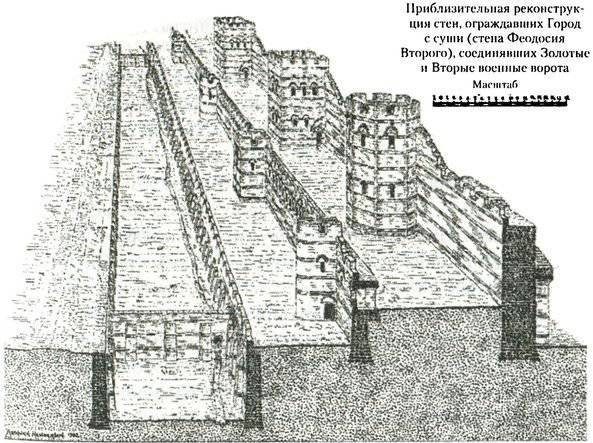
The location of the Greek troops
With a sufficient garrison, it was very difficult to take such a fortress at that time. The problem was that the Byzantine emperor did not have sufficient forces for the reliable defense of such an extensive system of fortifications. Constantine did not even have the strength to reliably cover all the main directions of a possible enemy attack and create strategic and operational reserves. I had to choose the most dangerous place, and close the rest of the directions with minimal forces (in fact, patrols).
Constantine XI Paleologue and Giovanni Giustiniani Longo decided to focus on the defense of the external walls. If the Ottomans broke through the external line of defense, there would simply be no reserves for a counter-offensive or the defense of a second line of fortifications. The main Greek forces under the command of the emperor himself defended Mesoichion. The direction was chosen correctly - the Turkish command precisely struck the main blow here. The shock unit of Giustiniani Longo was located on the right wing of the imperial troops - he defended the Charisian gates and the junction of the city wall with Vlaherurn, and while strengthening the enemy onslaught, he strengthened the forces of the emperor. This plot remained to be defended by the Genoese, led by the Bocciardi brothers (Paolo, Antonio and Troilo). The Venetian detachment under the command of Minotto defended Vlaherna in the area of the imperial palace.
On the emperor's left flank, the walls were guarded: a detachment of Genoese volunteers under the command of Cattaneo; the Greeks, led by a relative of the emperor Theophilus Paleolog; the section from Pigiysky to the Golden Gate is a connection of the Venetian Philippe Contarini; Golden Gate - the Genoese Manuele; plot to the sea - the Greek squad Dimitri Kantakuzin. Soldiers of Giacomo Contarini (Jacobo Contarini), then monks, carried the watch on the walls near the Sea of Marmara near Studiona. They were supposed to notify the command of the appearance of the enemy.
In the harbor area of Eleutheria, warriors of Prince Orhan were stationed. Near the hippodrome and the old imperial palace there were a few Catalan Pedro Julia, in the area of Acropolis - Cardinal Isidore. Fleet, located in the Gulf, commanded by Alvizo Diedo (Gyоd), part of the ships defended the chain at the entrance to the Golden Horn. The coast of the Golden Horn was guarded by Venetian and Genoese sailors under the leadership of Gabriele Trevisano. The city had two reserve units: the first with field artillery under the command of the first minister, Luca Notaras, was located in the Petra region; the second with Nicephorus Palaeologus - at the church of sv. Apostles.
Stubborn defense Byzantines hoped to gain time. If the defenders managed to hold out for a long time, then there was hope to get help from the Hungarian army or Italian squadrons. The plan was correct, if not for the Ottomans having powerful artillery capable of breaking through walls and a fleet, which made it possible to develop an offensive from all sides, including the Golden Horn.
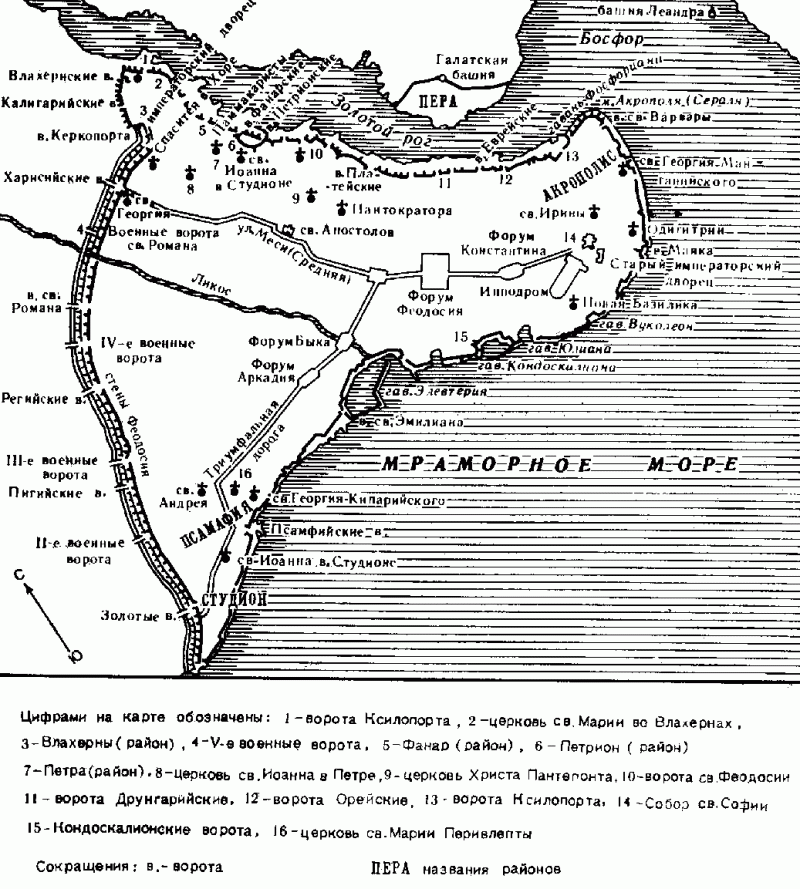
The location of the Turkish troops and the beginning of the siege
2 April 1453, the forward detachments of the Ottoman army reached the city. Residents of the city made a sortie. But as the enemy forces stayed, they pulled back the troops for the fortifications. All bridges over the moats were destroyed, the gates were laid. Through the Golden Horn stretched a chain.
On April 5, the main forces of the Ottomans approached Constantinople, by April 6 the city was completely blocked. The Turkish sultan offered Constantine to surrender the city without a fight, promising to give him the Morea despot, lifelong immunity and material reward. Residents of the capital promised immunity and preservation of property. In case of refusal - death. The Greeks refused to surrender. Constantine XI said that he was ready to pay any tribute that Byzantium could collect and cede any territory except Constantinople. Mehmed began to prepare the army for the assault.
Photo of the part of Panorama of 1453 (Historical Panorama Museum 1453 in Turkey).
A part of the Ottoman army under the command of Zaganos Pasha was sent to the north shore of the bay. The Ottomans blocked Peru. A pontoon bridge was laid across the marshy territory at the end of the bay in order to be able to maneuver troops. The Genoese were guaranteed the inviolability of Peru if the inhabitants of the suburbs did not resist. Mehmed was not going to take Peru so as not to quarrel with Genoa. Next to the Peruvian base was the Turkish fleet. He received the task of blocking the city from the sea, stopping the supply of reinforcements and provisions, as well as the flight of people from Constantinople itself. Baltoglu was supposed to break into the Golden Horn.
Regular units from the European part of the Ottoman Empire, under the command of Karadzhi Pasha, stood at Vlacherna. Under the command of Karadji Pasha there were heavy cannons, the batteries were supposed to destroy the junction of Theodosius’s walls with the Vlaherna fortifications. Sultan Mehmed with selected shelves and janissaries located in the valley of Lykos. Here are located the most powerful guns of Urbana. On the right flank - from the southern bank of the Lycos River to the Sea of Marmara, there were regular troops from the Anatolian part of the empire under the command of Iskhak Pasha and Makhmud Pasha. Behind the main forces in the second line were bashi-bazuk detachments. To protect themselves from possible attacks by the enemy, the Ottomans dug a ditch along the whole front, built a shaft with a paling.
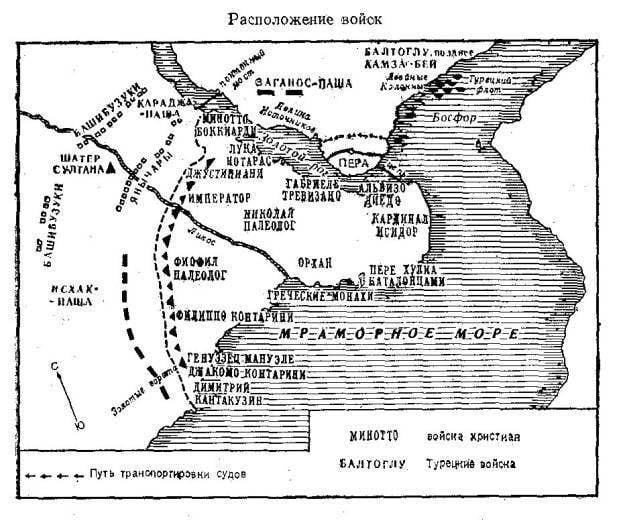
The Ottoman army had up to 70 guns in 15 batteries. Three batteries were installed at Vlacherna, two at the Harisian Gate, four - the gate of St. Romana, three - Pigian gates, two more, apparently, at the Golden Gate. The most powerful was hitting cores in half a ton, the second most powerful cannon was a projectile in 360 kg, the rest from 230 to 90 kg.
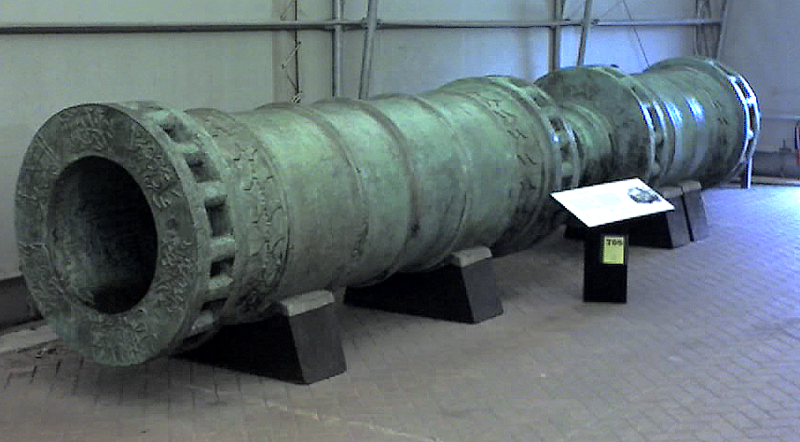
Dardanelles Cannon - an analogue of the "Basilica".
Mehmed could never storm the city. Constantinople blocked from all sides, would have lasted no more than six months. The Ottomans more than once took heavily fortified cities, deprived of food supplies and outside help, the fortress sooner or later surrendered. However, the Turkish Sultan wanted a brilliant victory. I wanted to immortalize my name for centuries, so on April 6 shelling of the city began. Powerful Turkish guns immediately damaged the walls in the area of the Harisian Gate, and 7 of April had a breach. On the same day, the Ottomans staged the first attack. The attack was directed poorly in the mass of armed volunteers and irregular units. But they met a skillful and stubborn resistance and were quite easily discarded.
The defenders of the city closed the breach at night. The Sultan ordered the moat to be filled up, more guns to be put in and the troops concentrated in this place in order to throw them at the assault when the guns struck again. At the same time began to prepare the digging. 9 On April, the Turkish ships tried to enter the Golden Horn, but were discarded. April 12 Turkish fleet again tried to break into the bay. The Byzantine fleet launched a counterattack, trying to cut off and destroy the Turkish vanguard. Baltoglu took the ships.
Part of the army was sent to capture the Byzantine forts. Castle Ferapia on a hill off the coast of the Bosphorus lasted two days. Then its walls were destroyed by Turkish artillery, most of the garrison died. A smaller fort at Studios, on the shores of the Sea of Marmara, was demolished in a few hours. The surviving defenders were impaled on the sight of the city.
In the early days of the Greeks made several attacks. But then Commander Giustiniani Longo decided that the benefits of such attacks were less than harm (there were not enough people already) and ordered that people be withdrawn from the first line of defense (the parapeal on the inner side of the moat) to the outer wall.
The Turkish command concentrated heavy weapons in the Lykos Valley and on April 12 began bombing a section of the wall. Among the guns there was such a giant as Basilica - this gun fired half a ton of cannonballs. However, due to the complexity of the service, the gun did not fire more often than 7 once a day. The basilica had tremendous destructive power. In order to somehow weaken its effect on the walls, the Greeks hung pieces of leather on the walls, bags of wool, but there was little use for this. A week later, Turkish artillery completely destroyed the outer wall above the riverbed. The moat of the Turks fell asleep. At night the Greeks tried to close the breach with barrels filled with earth, stones, logs. On the night of 17 on 18 on April, Turkish troops launched an assault on the breach. Light infantry was ahead - archers, javelin throwers, followed by heavy infantry, janissaries. The Ottomans carried with them torches in order to set fire to wooden barriers, hooks for hauling logs and assault ladders. Turkish warriors in a narrow breach did not have a numerical advantage, besides, the superiority of the Greeks in protective armaments was affected. After a four-hour fierce battle, the Ottomans rolled back.
To be continued ...
- Alexander Samsonov
- Byzantine lessons. To the 560 anniversary of the fall of Constantinople
Byzantine lessons. To the 560 anniversary of the fall of Constantinople. Part of 2
Byzantine lessons. To the 560 anniversary of the fall of Constantinople. Part of 3
Byzantine lessons. To the 560 anniversary of the fall of Constantinople. Part of 4
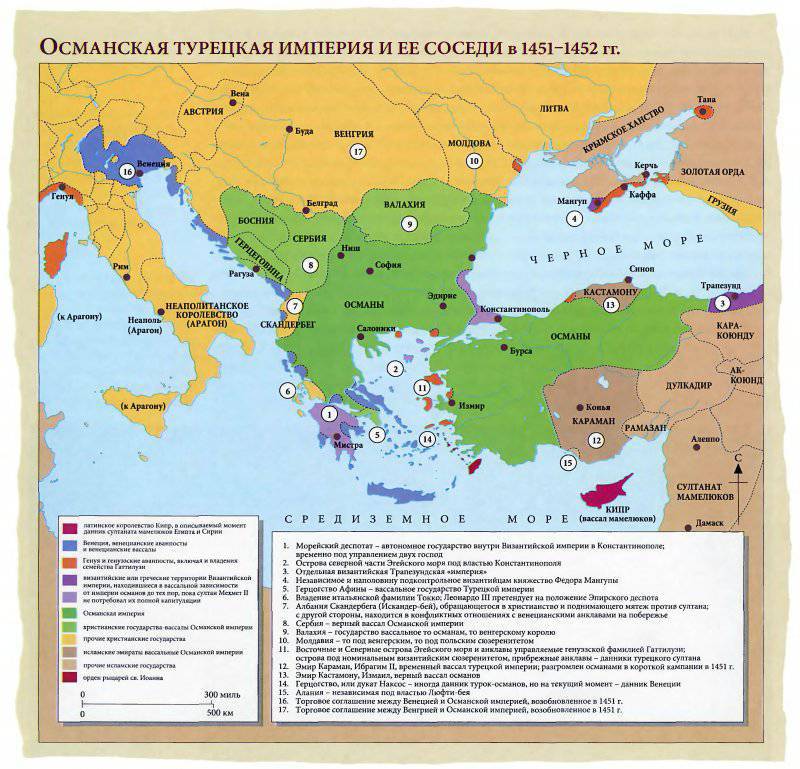
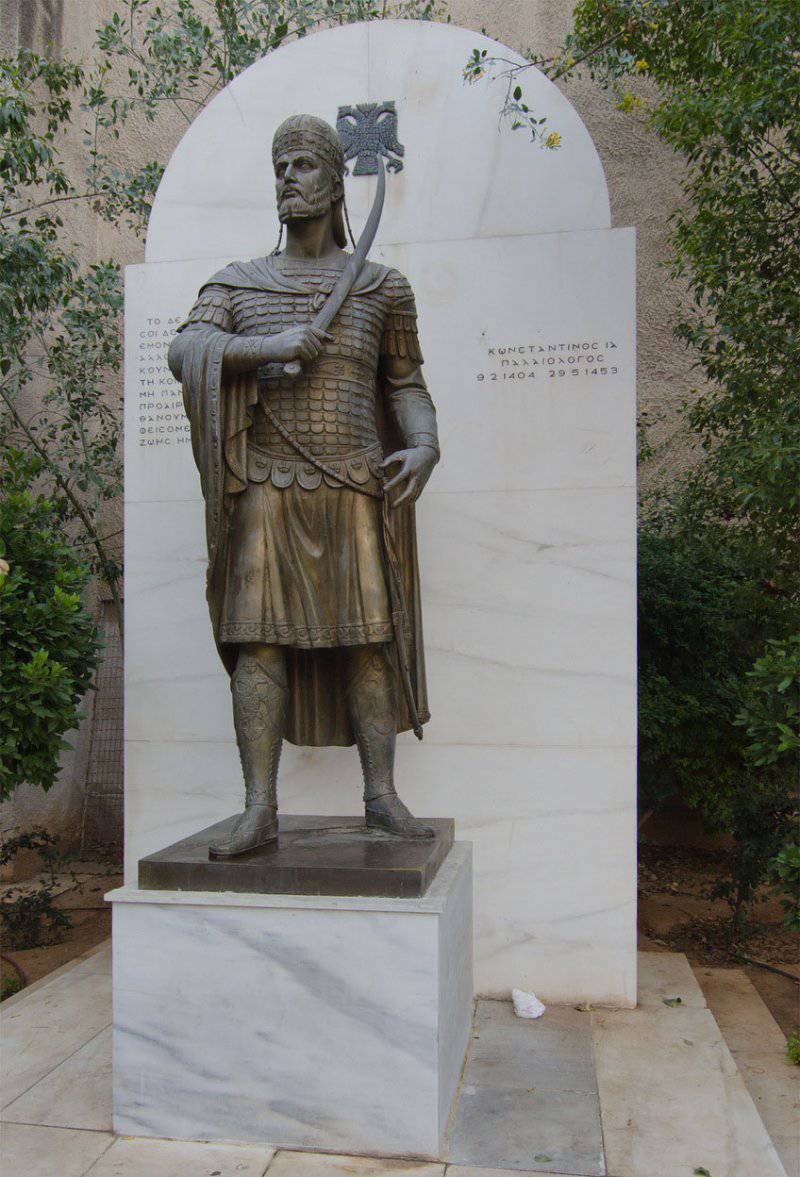
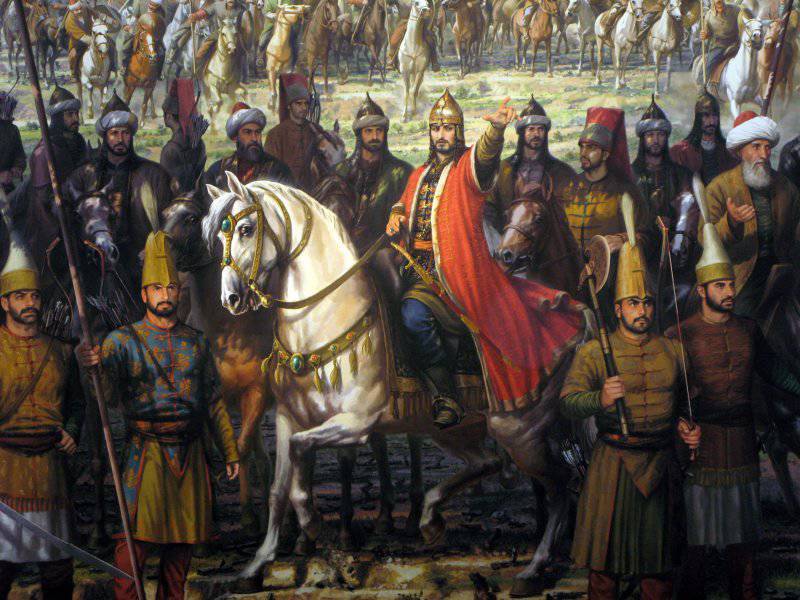
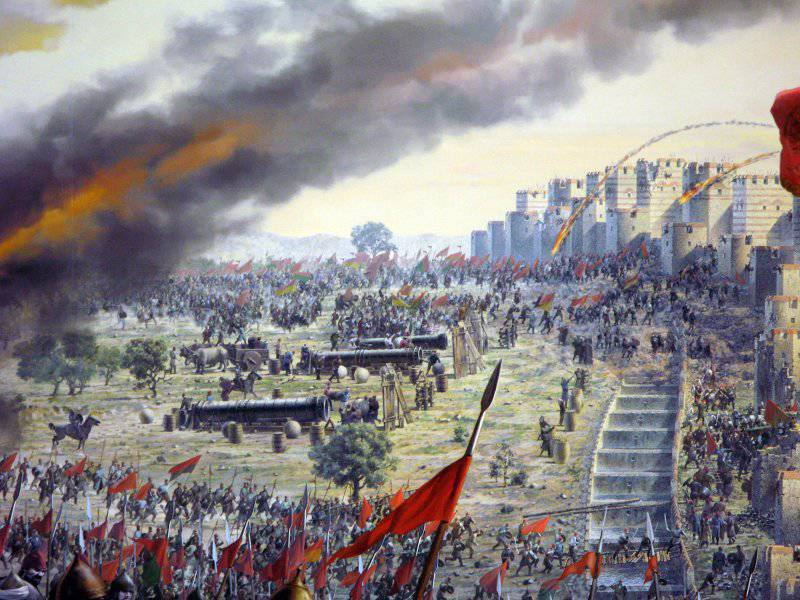
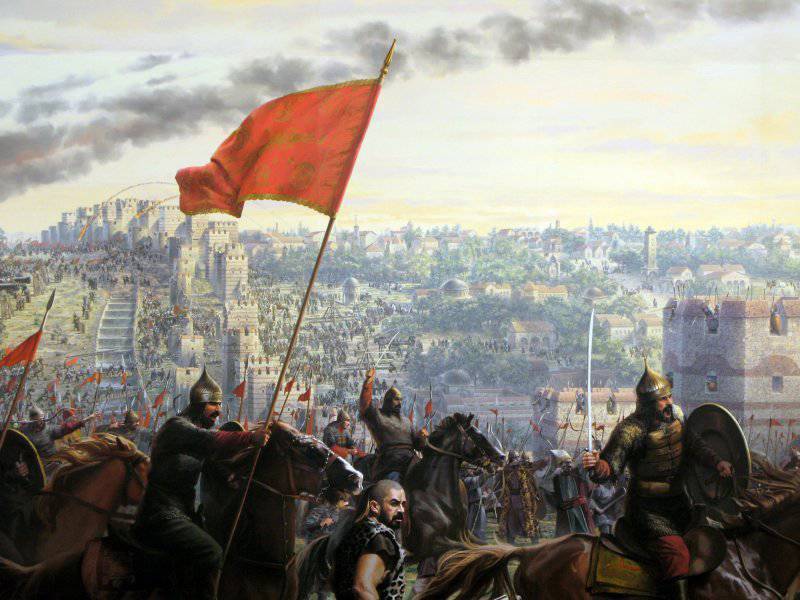
Information